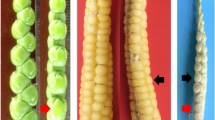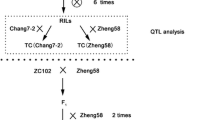Abstract
Ear row number (ERN) is not only a key trait involved in maize (Zea mays L.) evolution but also an important component directly related to grain yield. In this report, 325 recombinant inbred lines (RILs, F6:7) derived from a cross between B73 with 16 rows and SICAU1212 with four rows (two-ranked with two rows per rank) were utilized to detect quantitative trait loci (QTL) associated with ERN and two-ranked versus many-ranked ears (TR). Compared to modern maize that formed approximately 8–20 rows, SICAU1212 with four rows was the extreme case. A total of 12 and 8 QTLs were associated with ERN and TR across four environments through single-environment mapping, respectively. Each QTL responsible for ERN explained 2.33–21.28 % of the phenotypic variation. And the TR variation contributed by individual TR QTL ranged from 2.09 to 12.99 %. Notably, only three QTLs, qERN2-1 (bin 2.02), qERN8-1 (bin 8.02) and qERN8-2 (bin 8.04), were consistently detected in each environment and by joint analysis among all environments, which simultaneously influenced ERN and TR. One of the three QTLs, qERN8-1 was also identified as interacting with environment. In addition, nine pairs of significant epistatic interactions (two for ERN and seven for TR) were detected among all QTLs. The epistasis between qTR2-1 and qTR8-1 was consistent in most environments. This present study may provide the understanding of the genetic basis of ERN and TR and a foundation for further fine-mapping of these common QTLs.




Similar content being viewed by others
References
Austin DF, Lee M (1996) Comparative mapping in F2:3 and F6:7 generations of quantitative trait loci for grain yield and yield components in maize. Theor Appl Genet 92:817–826
Barazesh S, McSteen P (2008) Barren inflorescence1 functions in organogenesis during vegetative and inflorescence development in maize. Genetics 179:389–401
Beavis WD, Smith OS, Grant D, Fincher R (1994) Identification of quantitative trait loci using a small sample of topcrossed and F4 progeny from maize. Crop Sci 34:882–896
Benz BF (2001) Archaeological evidence of teosinte domestication from Guilá Naquitz, Oaxaca. Proc Natl Acad Sci 98:2104–2106
Bomblies K, Doebley JF (2006) Pleiotropic effects of the duplicate maize FLORICAULA/LEAFY genes zfl1 and zfl2 on traits under selection during maize domestication. Genetics 172:519–531
Bomblies K, Wang R-L, Ambrose BA, Schmidt RJ, Meeley RB, Doebley J (2003) Duplicate FLORICAULA/LEAFY homologs zfl1 and zfl2 control inflorescence architecture and flower patterning in maize. Development 130:2385–2395
Bommert P, Nagasawa NS, Jackson D (2013) Quantitative variation in maize kernel row number is controlled by the FASCIATED EAR2 locus. Nat Genet 45:334–337
Briggs WH, McMullen MD, Gaut BS, Doebley J (2007) Linkage mapping of domestication loci in a large maize–teosinte backcross resource. Genetics 177:1915–1928
Brown PJ, Upadyayula N, Mahone GS, Tian F, Bradbury PJ, Myles S, Holland JB, Flint-Garcia S, McMullen MD, Buckler ES (2011) Distinct genetic architectures for male and female inflorescence traits of maize. PLoS Genet 7:e1002383
Cai L, Li K, Yang X, Li J (2014) Identification of large-effect QTL for kernel row number has potential for maize yield improvement. Mol Breed 34:1087–1096
Carlborg Ö, Haley CS (2004) Epistasis: too often neglected in complex trait studies? Nat Rev Genet 5:618–625
Choe E, Rocheford TR (2012) Genetic and QTL analysis of pericarp thickness and ear architecture traits of Korean waxy corn germplasm. Euphytica 183:243–260
Chuck GS, Brown PJ, Meeley R, Hake S (2014) Maize SBP-box transcription factors unbranched2 and unbranched3 affect yield traits by regulating the rate of lateral primordia initiation. Proc Natl Acad Sci 111:18775–18780
Churchill GA, Doerge RW (1994) Empirical threshold values for quantitative trait mapping. Genetics 138:963–971
Collard BC, Mackill DJ (2008) Marker-assisted selection: an approach for precision plant breeding in the twenty-first century. Philos Trans R Soc Lond B Biol Sci 363:557–572
Cowen N (1988) The use of replicated progenies in marker-based mapping of QTL’s. Theor Appl Genet 75:857–862
Daniel L (1963) Analysis of inheritance of the number of kernel rows in maize. Theor Appl Genet 33:290–301
Darvasi A, Soller M (1997) A simple method to calculate resolving power and confidence interval of QTL map location. Behav Genet 27:125–132
Doebley J (1992) Mapping the genes that made maize. Trends Genet 8:302–307
Doebley J (2004) The genetics of maize evolution. Annu Rev Genet 38:37–59
Doebley J, Stec A (1991) Genetic analysis of the morphological differences between maize and teosinte. Genetics 129:285–295
Doebley J, Stec A (1993) Inheritance of the morphological differences between maize and teosinte: comparison of results for two F2 populations. Genetics 134:559–570
Doebley J, Stec A, Wendel J, Edwards M (1990) Genetic and morphological analysis of a maize-teosinte F2 population: implications for the origin of maize. Proc Natl Acad Sci 87:9888–9892
Doebley J, Stec A, Kent B (1995) Suppressor of sessile spikelets 1 (Sos1): a dominant mutant affecting inflorescence development in maize. Am J Bot 82:571–577
Dofing S, ĎCroz-Mason N, Thomas-Compton M (1991) Inheritance of expansion volume and yield in two popcorn × dent corn crosses. Crop Sci 31:715–718
Edwards M, Stuber C, Wendel J (1987) Molecular-marker-facilitated investigations of quantitative-trait loci in maize. I. Numbers, genomic distribution and types of gene action. Genetics 116:113–125
Fan C, Xing Y, Mao H, Lu T, Han B, Xu C, Li X, Zhang Q (2006) GS3, a major QTL for grain length and weight and minor QTL for grain width and thickness in rice, encodes a putative transmembrane protein. Theor Appl Genet 112:1164–1171
Gallavotti A, Long JA, Stanfield S, Yang X, Jackson D, Vollbrecht E, Schmidt RJ (2010) The control of axillary meristem fate in the maize ramosa pathway. Development 137:2849–2856
Guo J, Su G, Zhang J, Wang G (2008) Genetic analysis and QTL mapping of maize yield and associate agronomic traits under semi-arid land condition. Afr J Biotechnol 7:1829–1838
Hallauer AR, Miranda J (1988) Quantitative genetics in maize breeding, 2nd edn. Iowa State Univ Press, Ames
Iltis HH (1983) From teosinte to maize: the catastrophic sexual transmutation. Science 222:886–894
Iltis HH (2000) Homeotic sexual translocations and the origin of maize (Zea mays, Poaceae): a new look at an old problem. Econ Bot 54:7–42
Jiao F, Li Y, Chen L, Liu Z, Shi Y, Song Y, Zhang D, Li Y, Wang T (2014) Genetics dissection for kernel row number in the specific maize germplasm four-rowed waxy corn. Sci Agric Sin 47:1256–1264
Kalinowski ST (2004) Counting alleles with rarefaction: private alleles and hierarchical sampling designs. Conserv Genet 5:539–543
Kalinowski ST (2005) hp-rare 1.0: a computer program for performing rarefaction on measures of allelic richness. Mol Ecol Notes 5:187–189
Karen Sabadin P, de Souza Lopes, Júnior C, Pereira de Souza A, Augusto Franco Garcia A (2008) QTL mapping for yield components in a tropical maize population using microsatellite markers. Hereditas 145:194–203
Knapp SJ, Stroup WW, Ross WM (1985) Exact confidence intervals for heritability on a progeny mean basis. Crop Sci 25:192–194
Langham DG (1940) The inheritance of intergeneric differences in Zea-Euchlaena hybrids. Genetics 25:88–107
Lauter N, Doebley J (2002) Genetic variation for phenotypically invariant traits detected in teosinte: implications for the evolution of novel forms. Genetics 160:333–342
Lemmon ZH, Doebley JF (2014) Genetic dissection of a genomic region with pleiotropic effects on domestication traits in maize reveals multiple linked QTL. Genetics 198:345–353
Leng ER (1963) Component analysis in inheritance studies of grain yield in maize. Crop Sci 3:187–190
Li Y, Niu S, Dong Y, Cui D, Wang Y, Liu Y, Wei M (2007) Identification of trait-improving quantitative trait loci for grain yield components from a dent corn inbred line in an advanced backcross BC2F2 population and comparison with its F2:3 population in popcorn. Theor Appl Genet 115:129–140
Li H, Ribaut J-M, Li Z, Wang J (2008) Inclusive composite interval mapping (ICIM) for digenic epistasis of quantitative traits in biparental populations. Theor Appl Genet 116:243–260
Li Y, Li X, Li J, Fu J, Wang Y, Wei M (2009) Dent corn genetic background influences QTL detection for grain yield and yield components in high-oil maize. Euphytica 169:273–284
Li M, Guo X, Zhang M, Wang X, Zhang G, Tian Y, Wang Z (2010) Mapping QTLs for grain yield and yield components under high and low phosphorus treatments in maize (Zea mays L.). Plant Sci 178:454–462
Li J, Zhang Z, Li Y, Wang Q, Zhou Y (2011) QTL consistency and meta-analysis for grain yield components in three generations in maize. Theor Appl Genet 122:771–782
Li F, Jia H, Liu L, Zhang C, Liu Z, Zhang Z (2014a) Quantitative trait loci mapping for kernel row number using chromosome segment substitution lines in maize. Genet Mol Res 13:1707–1716
Li Y, Fan C, Xing Y, Yun P, Luo L, Yan B, Peng B, Xie W, Wang G, Li X (2014b) Chalk5 encodes a vacuolar H+-translocating pyrophosphatase influencing grain chalkiness in rice. Nat Genet 46:398–404
Lincoln SE (1992) Mapping genes controlling quantitative traits with MAPMAKER/QTL 1.1. Whitehead Institute Technical Report
Liu X, He S, Zheng Z, Huang Y, Tan Z, Wu X (2010) QTL identification for row number per ear and grain number per row in maize. Maydica 55:127–133
Liu Y, Wang L, Sun C, Zhang Z, Zheng Y, Qiu F (2014) Genetic analysis and major QTL detection for maize kernel size and weight in multi-environments. Theor Appl Genet 127:1019–1037
Lu GH, Tang JH, Yan JB, Ma XQ, Li JS, Chen SJ, Ma JC, Liu ZX, Zhang YR, Dai JR (2006) Quantitative trait loci mapping of maize yield and its components under different water treatments at flowering time. J Integr Plant Biol 48:1233–1243
Lu M, Xie C-X, Li X-H, Hao Z-F, Li M-S, Weng J-F, Zhang D-G, Bai L, Zhang S-H (2011) Mapping of quantitative trait loci for kernel row number in maize across seven environments. Mol Breed 28:143–152
Mangelsdorf PC (1947) The origin and evolution of maize. Adv Genet 1:161–207
Mao H, Sun S, Yao J, Wang C, Yu S, Xu C, Li X, Zhang Q (2010) Linking differential domain functions of the GS3 protein to natural variation of grain size in rice. Proc Natl Acad Sci 107:19579–19584
Melchinger AE, Utz HF, Schön CC (1998) Quantitative trait locus (QTL) mapping using different testers and independent population samples in maize reveals low power of QTL detection and large bias in estimates of QTL effects. Genetics 149:383–403
Orr AR, Mullen K, Klaahsen D, Sundberg MD (2002) Inflorescence development in a high-altitude annual Mexican teosinte (Poaceae). Am J Bot 89:1730–1740
Petrovic Z (1998) Combining abilities and mode of inheritance of yield and yield components in maize (Zea mays L.). NoviSad 8:81–85
Phillips PC (2008) Epistasis—the essential role of gene interactions in the structure and evolution of genetic systems. Nat Rev Genet 9:855–867
Phillips KA, Skirpan AL, Liu X, Christensen A, Slewinski TL, Hudson C, Barazesh S, Cohen JD, Malcomber S, McSteen P (2011) vanishing tassel2 encodes a grass-specific tryptophan aminotransferase required for vegetative and reproductive development in maize. Plant Cell 23:550–566
Qi Z, Wu Q, Han X, Sun Y, Du X, Liu C, Jiang H, Hu G, Chen Q (2011) Soybean oil content QTL mapping and integrating with meta-analysis method for mining genes. Euphytica 179:499–514
Robertson DS (1985) A possible technique for isolating genic DNA for quantitative traits in plants. J Theor Biol 117:1–10
Rogers JS (1950) The inheritance of inflorescence characters in maize-teosinte hybrids. Genetics 35:541–558
Sa KJ, Park JY, Woo SY, Ramekar RV, Jang C-S, Lee JK (2015) Mapping of QTL traits in corn using a RIL population derived from a cross of dent corn × waxy corn. Genes Genom 37:1–14
Saghai-Maroof M, Soliman K, Jorgensen RA, Allard R (1984) Ribosomal DNA spacer-length polymorphisms in barley: mendelian inheritance, chromosomal location, and population dynamics. Proc Natl Acad Sci 81:8014–8018
Santos FR, Pena SD, Epplen JT (1993) Genetic and population study of a Y-linked tetranucleotide repeat DNA polymorphism with a simple non-isotopic technique. Hum Genet 90:655–656
Sreckov Z, Nastasic A, Bocanski J, Djalovic I, Vukosavljev M, Jockovic B (2011) Correlation and path analysis of grain yield and morphological traits in test–cross populations of maize. Pak J Bot 43:1729–1731
Stuber CW, Edwards MD, Wendel JF (1987) Molecular marker-facilitated investigations of quantitative trait loci in maize. II. Factors influencing yield and its component traits. Crop Sci 27:639–648
Szabó VM, Burr B (1996) Simple inheritance of key traits distinguishing maize and teosinte. Mol Gen Genet 252:33–41
Taguchi-Shiobara F, Yuan Z, Hake S, Jackson D (2001) The fasciated ear2 gene encodes a leucine-rich repeat receptor-like protein that regulates shoot meristem proliferation in maize. Genes Dev 15:2755–2766
Tan Y, Xing Y, Li J, Yu S, Xu C, Zhang Q (2000) Genetic bases of appearance quality of rice grains in Shanyou 63, an elite rice hybrid. Theor Appl Genet 101:823–829
Tang J, Yan J, Ma X, Teng W, Wu W, Dai J, Dhillon BS, Melchinger AE, Li J (2010) Dissection of the genetic basis of heterosis in an elite maize hybrid by QTL mapping in an immortalized F2 population. Theor Appl Genet 120:333–340
Tian M, Tan G, Liu Y, Rong T, Huang Y (2009) Origin and evolution of Chinese waxy maize: evidence from the Globulin-1 gene. Genet Resour Crop Evol 56:247–255
Tian B, Wang J, Wang G (2014) Confirmation of a major QTL on chromosome 10 for maize kernel row number in different environments. Plant Breed 133:184–188
Upadyayula N, Da Silva H, Bohn M, Rocheford T (2006) Genetic and QTL analysis of maize tassel and ear inflorescence architecture. Theor Appl Genet 112:592–606
Veldboom LR, Lee M (1994) Molecular-marker-facilitated studies of morphological traits in maize. II: determination of QTLs for grain yield and yield components. Theor Appl Genet 89:451–458
Veldboom LR, Lee M (1996) Genetic mapping of quantitative trait loci in maize in stress and nonstress environments: I. Grain yield and yield components. Crop Sci 36:1310–1319
Yan J, Tang H, Huang Y, Zheng Y, Li J (2006) Quantitative trait loci mapping and epistatic analysis for grain yield and yield components using molecular markers with an elite maize hybrid. Euphytica 149:121–131
Yang J, Zhu J, Williams RW (2007) Mapping the genetic architecture of complex traits in experimental populations. Bioinformatics 23:1527–1536
Yu Y, Li G, Yang Z, Hu J, Zheng J, Qi X (2014) Identification of a major quantitative trait locus for ear size induced by space flight in sweet corn. Genet Mol Res 13:3069–3078
Zeng M, Yang T, Wang P (1981) The relative analyses of maize cultivar menghai four-row wax. Acta Genet Sin 8:91–96
Zhang G, Wang X, Wang B, Tian Y, Li M, Nie Y, Peng Q, Wang Z (2013) Fine mapping a major QTL for kernel number per row under different phosphorus regimes in maize (Zea mays L.). Theor Appl Genet 126:1545–1553
Zhang Z, Liu Z, Hu Y, Li W, Fu Z, Ding D, Li H, Qiao M, Tang J (2014) QTL analysis of kernel-related traits in maize using an immortalized F2 population. PLoS ONE 9:e89645
Zhou J, Fang H, Shan J, Gao X, Chen L, Xie C, Xie T, Liu J (2014) A major QTL located on chromosome V associates with in vitro tuberization in a tetraploid potato population. Mol Genet Genomics 289:575–587
Acknowledgments
We greatly appreciate Dr. Wenming Wang, Zhiming Zhang, Jihua Tang, Yaou Shen, Yanli Lu and Yuanqi Wu for suggestions and revisions to this manuscript. This research was supported by the National Basic Research Program of China (the “973” project, 2014CB138203) and National Natural Science Foundation of China (31101161).
Conflict of interest
All of the authors declare that they have no conflict of interest.
Ethical standards
The experiments comply with the current laws of the country in which they were performed.
Author information
Authors and Affiliations
Corresponding authors
Electronic supplementary material
Below is the link to the electronic supplementary material.
Rights and permissions
About this article
Cite this article
Yang, C., Tang, D., Zhang, L. et al. Identification of QTL for ear row number and two-ranked versus many-ranked ear in maize across four environments. Euphytica 206, 33–47 (2015). https://doi.org/10.1007/s10681-015-1466-4
Received:
Accepted:
Published:
Issue Date:
DOI: https://doi.org/10.1007/s10681-015-1466-4




